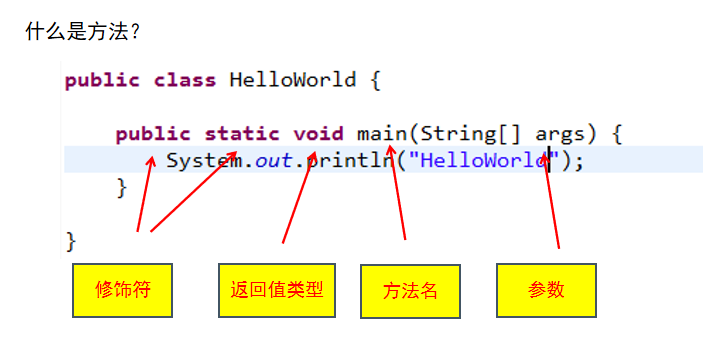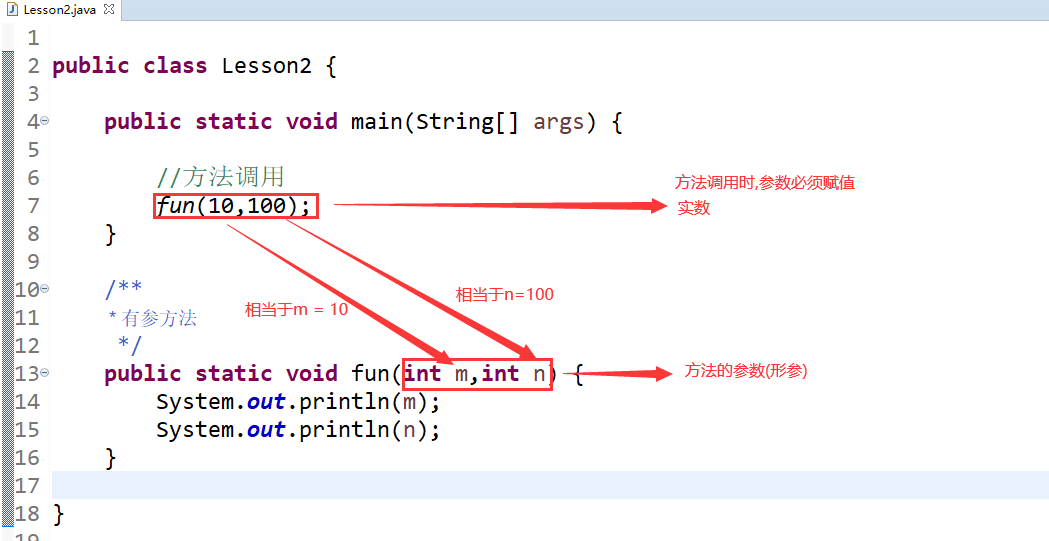Java方法
一、方法概述
1.为什么要用方法?
1.解决代码的重复性问题
2.如果把代码都放在程序的入口main中,程序会非常臃肿,不便于维护
3.提高代码的可重用性
2.什么是方法?
定义在类中的具有特定功能的一段独立程序,称之为方法。

二、使用步骤
1.定义
/**
* 自定义方法
*/
public static void fun1() {
System.out.println("刘媛婷唱的xxx歌");
}
2.在main方法中调用
/**
* 主方法,程序的入口
*/
public static void main(String[] args) {
//自定义方法需要在主方法中调用
fun1();
fun1();
fun1();
}
三、方法的形参和实参

四、数组类型的参数
public static void main(String[] args) {
int[] array = {3,5,1,7,6};
//方法调用
fun(array);
}
/**
* 如何在自定义方法中遍历主方法中定义的数组
*/
public static void fun(int[] arr) {
for (int i = 0; i < arr.length; i++) {
System.out.println(arr[i]);
}
}
五、带返回值的方法
public class Lesson4 {
public static void main(String[] args) {
int n = fun();
System.out.println(n);
}
/**
* 如何在主方法中输出自定义方法中某个变量的值
* 使用方法的返回值值实现
*/
public static int fun() {
return 100;
}
}
六、方法的分类
/**
* 方法的分类
* @author Administrator
*
*/
public class Lesson5 {
public static void main(String[] args) {
// TODO Auto-generated method stub
}
/**
* 无参无返回值
*/
public static void fun1() {
}
/**
* 有参无返回值
*/
public static void fun2(int n) {
}
/**
* 无参有返回值
*/
public static int fun3() {
return 100;
}
/**
* 有参有返回值
*/
public static int fun4(int m) {
return 200;
}
}
七、方法的重载
/**
* 方法的重载
* 多个方法,方法名称一样,参数列表不一样(参数个数,或者数据类型不一样),就叫方法的重载
* 方法的重载跟参数的名称没有关系
* 方法重载的调用,根据调用时传入的实参个数和类型,自动选择需要调用的方法
*/
public class Lesson6 {
public static void main(String[] args) {
sum("hello",2);
}
public static void sum(int a,int b) {
System.out.println("有2个参数的方法");
int result = a + b;
System.out.println(result);
}
public static void sum(int a,int b,int c) {
System.out.println("有3个参数的方法");
int result = a + b + c;
System.out.println(result);
}
public static void sum(String a,int b) {
System.out.println("有字符串参数的方法");
String result = a + b;
System.out.println(result);
}
}
八、任意个数参数的方法
实现方法在调用的时候,可以传递任意的参数个数
public class Lesson7 {
public static void main(String[] args) {
fun(1,2,3,4,5,6,7,8);
}
/**
* 任意个数参数的方法
* 方法以伪数组的形式接收实参
*/
public static void fun(int ...a) {
System.out.println(a.length);
for (int i = 0; i < a.length; i++) {
System.out.println(a[i]);
}
}
}
注:
我们在使用的时候,优先考虑固定参数个数的方法
九、static
//a.被static修饰的方法,只能调用被static修饰的语法
//b.非static方法,可以调用static语法,也可以调用非static语法
//c.static方法,也称为全局方法;可以在整个项目的任何类中,通过 类名.方法名 调用
//d.被public static修饰的变量叫全局变量,可以在整个项目的任何类中,通过类名.变量名 访问
public class Lesson9 {
public static int n = 100;
public static void main(String[] args) {
//fun1();
// System.out.println(n);
}
public static void fun2() {
System.out.println("我是lesson9中的方法");
}
public void fun1() {
fun2();
System.out.println(n);
}
}
十、变量的作用域
1.局部变量
把在方法里面定义的变量称为局部变量,只能在方法内部使用
2.成员变量
在方法外面类里面定义的变量,在类中的所有方法里面都可以使用
成员变量有初始值
3.全局变量
在成员变量的基础上加public static修饰,全局变量在整个项目里面都可以直接使用
在其它类中使用类名.全局变量名访问
注:
如果局部变量跟成员变量或者全局变量的名称一致,在使用的时候遵循就近原则
在方法里面要使用某一个变量时,先在方法里面找这个变量,找到就使用,找不到再去方法外面找
/**
* 变量的作用域
* 1.局部变量--定义在方法中--只能在该方法中使用
* 2.成员变量--定义在方法外面,类里面--可以在该类中所有的非静态方法中使用
* 3.全局变量--在成员变量的前面加上public static--可以在项目的所有类中使用
*/
public class Exam4 {
//成员变量
String name = "赵日天";
//全局变量
public static int age = 100;
public static void main(String[] args) {
//局部变量
int n = 100;
if(true) {
System.out.println(n);
}
}
}






















 8487
8487











 被折叠的 条评论
为什么被折叠?
被折叠的 条评论
为什么被折叠?








